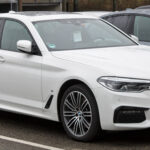BMW vs Mercedes: (Depreciation Comparison)
BMW and Mercedes are German multinational manufacturers of luxury vehicles. Both brands are the leaders of the luxury car market, with combined revenue of more than 300 billion dollars. Mercedes is the biggest luxury car brand in the world, and BMW sits second on that list.
In general, luxury cars depreciate at a much higher rate than other vehicles. People looking for a used luxury car are often interested to compare BMW vs Mercedes depreciation.
In this article, you will get to know everything about the depreciation of both car brands along with the comparison of their popular models.
BMW vs. Mercedes-Benz- a General Resale Value Comparison
Mercedes has better value retention than BMW for most of the years. BMW only takes the lead in the third, fourth, and fifth years. For the rest of the years, Mercedes has a better resale value.
The difference between their depreciation rate isn’t that huge, and it remains less than 5 percent throughout the entire lifespan. Both car brands follow the general trend and lose most of their value during the initial years.
The average depreciation of BMW and Mercedes car brands can be seen in the below table.
| Vehicle Age | BMW Depreciation | Mercedes Depreciation |
| 1 | 77% | 81% |
| 2 | 68% | 71% |
| 3 | 62% | 61% |
| 4 | 55% | 53% |
| 5 | 46% | 45% |
| 6 | 39% | 41% |
| 7 | 33% | 36% |
| 8 | 29% | 30% |
| 9 | 24% | 28% |
| 10 | 22% | 25% |
| 11 | 19% | 21% |
| 12 | 15% | 20% |
The below graph shows the BMW vs Mercedes year-to-year average depreciation. As it can be seen that both lines have a similar curve and remain very close to each other. Overall, Mercedes performs slightly better than BMW and takes the lead during the second half of the vehicle’s age.

Now let’s compare popular BMW and Mercedes car models side by side and see which car model outperforms the other.
Also read: Mercedes vs. BMW- Which is Cheaper to Maintain?
BMW 1 Series vs. Mercedes-Benz A-Class
BMW 1 Series has an overall better resale value. Mercedes-Benz A-Class starts very strong and takes the lead during 1st and 2nd year. After that, the 1 Series depreciates at a slower rate than the A-Class.
Both models are subcompact executive vehicles and come with different body styles and engine options. In the below table it can be seen that the only time during which the A-Class beats the 1 Series are the first and second years. For the rest of the years, BMW 1 Series better holds its value.
| Vehicle Age | BMW 1 Series Depreciation | BMW 1 Series Residual Value | Mercedes-Benz A-Class Depreciation | Mercedes-Benz A-Class Residual Value |
| 1 | 75% | $37,223 | 83% | $34,282 |
| 2 | 69% | $34,431 | 73% | $30,028 |
| 3 | 64% | $31,849 | 61% | $25,377 |
| 4 | 59% | $29,460 | 54% | $22,498 |
| 5 | 49% | $24,400 | 48% | $19,806 |
| 6 | 47% | $23,198 | 43% | $17,714 |
| 7 | 38% | $18,896 | 36% | $14,973 |
| 8 | 37% | $18,213 | 28% | $11,506 |
| 9 | 32% | $15,969 | 25% | $10,280 |
| 10 | 31% | $15,665 | 22% | $8,967 |
The initial selling price of the BMW 1 Series is $49,857 and it retains 49 percent of its value after five years. Whereas the initial selling price of the Mercedes-Benz A-Class is $41,418 and it retains 48 percent of the value after five years.
The below graph compares the residual value of both car models against their age.

BMW 3 Series vs. Mercedes-Benz C-Class
Mercedes-Benz C-Class has a better resale value during the first half of the vehicle’s lifespan. BMW 3 Series catches up after the sixth year and maintains that lead for the rest of the years.
Both car models belong to the category of compact executive cars. BMW 3 Series is the best-selling model of BMW and accounts for around 30% of the total sales. Mercedes-Benz C-Class is also very popular and it has been in production since 1993.
Trending Video: How to Easily Bring Back to Life any Old Car Battery and Save Tons of Money (click to watch)
Mercedes-Benz C-Class successfully competes with 3 Series during the initial years but BMW Series 3 takes the lead in the long run.
| Vehicle Age | BMW 3 Series Depreciation | BMW 3 Series Residual Value | Mercedes-Benz C-Class Depreciation | Mercedes-Benz C-Class Residual Value |
| 1 | 81% | $34,643 | 82% | $43,861 |
| 2 | 69% | $29,391 | 73% | $39,119 |
| 3 | 61% | $26,127 | 65% | $34,731 |
| 4 | 58% | $24,807 | 52% | $28,119 |
| 5 | 45% | $19,324 | 47% | $25,387 |
| 6 | 38% | $16,291 | 42% | $22,333 |
| 7 | 35% | $14,792 | 28% | $15,083 |
| 8 | 31% | $13,417 | 26% | $13,942 |
| 9 | 29% | $12,397 | 22% | $11,868 |
| 10 | 22% | $9,527 | 20% | $10,609 |
After five years of operation, BMW 3 Series depreciates 55 percent. On the other hand, Mercedes-Benz C-Class only depreciates 53 percent after five years. The initial selling price of the 3 Series is $42,838 and the C-Class is a bit expensive and comes with a price tag of $53,581.
The below graph compares the residual value of both car models against their age.

Also read: Mercedes-Benz C-Class Running Costs (1, 3, 5 Years)
BMW 5 Series vs. Mercedes-Benz E-Class
During the first four years, BMW 5 Series has a better resale value. For the rest of the years, Mercedes-Benz E-Class emerges as a winner and better holds its value.
Both car models directly compete against each other and belong to the category of executive cars. The E-Class is the best-selling model of Mercedes-Benz. Due to the very high initial cost, it depreciates quickly during the initial years but better holds its value in the later years.
| Vehicle Age | BMW 5 Series Depreciation | BMW 5 Series Residual Value | Mercedes-Benz E-Class Depreciation | Mercedes-Benz E-Class Residual Value |
| 1 | 79% | $46,325 | 76% | $59,491 |
| 2 | 67% | $39,155 | 70% | $54,580 |
| 3 | 61% | $35,688 | 58% | $45,336 |
| 4 | 54% | $31,368 | 51% | $40,035 |
| 5 | 43% | $25,343 | 50% | $38,864 |
| 6 | 36% | $21,040 | 44% | $34,063 |
| 7 | 33% | $19,131 | 37% | $29,082 |
| 8 | 27% | $15,494 | 30% | $23,289 |
| 9 | 22% | $12,715 | 26% | $20,166 |
| 10 | 21% | $12,330 | 24% | $18,394 |
The initial selling price of the BMW 5 Series is $58,380 and it depreciates 57 percent after five years. Whereas the initial selling price of the Mercedes-Benz E-Class is $78,072 and it holds an impressive 50 percent of its value after five years.
The below graph compares the residual value of both car models against their age.
Also read: 3 Reasons Why Luxury Cars Depreciate so Quickly

BMW X5 vs. Mercedes-Benz GLE
BMW X5 depreciates at a slower rate than the Mercedes-Benz GLE. It has a better resale value than the GLE except for the last three years.
Both of these car models fall under the category of mid-size luxury SUVs. They also have a similar initial price of around $83,500.
The Mercedes-Benz GLE depreciates very quickly and lose 30 percent of its value in the first alone. BMW X5 only depreciates 24 percent after one year and only loses to GLE after the seventh year of its lifespan.
| Vehicle Age | BMW X5 Depreciation | BMW X5 Residual Value | Mercedes-Benz GLE Depreciation | Mercedes-Benz GLE Residual Value |
| 1 | 76% | $63,332 | 70% | $58,182 |
| 2 | 73% | $60,908 | 64% | $53,135 |
| 3 | 62% | $51,454 | 53% | $44,136 |
| 4 | 56% | $46,498 | 43% | $35,972 |
| 5 | 43% | $36,267 | 35% | $28,895 |
| 6 | 38% | $31,428 | 32% | $26,728 |
| 7 | 33% | $27,416 | 30% | $24,723 |
| 8 | 23% | $19,626 | 27% | $22,869 |
| 9 | 19% | $15,522 | 25% | $21,154 |
| 10 | 17% | $14,251 | 23% | $19,567 |
The below graph compares the residual value of both car models against their age.

Also read: 3 Best BMWs for Family of 5 (with Photos)
BMW X3 vs Mercedes-Benz GLC
BMW X3 better holds its value for the first four years but for the rest of the lifespan, Mercedes-Benz GLC has a better resale value.
Mercedes-Benz GLC performs poorly during the first half and loses 37 percent of its value after 2 years. BMW X3 only loses 25 percent of its value after two years but depreciates quickly after the fourth year. From the 4th year and onwards, the GLC beats X3 in terms of value retention.
| Vehicle Age | BMW X3 Depreciation | BMW X3 Residual Value | Mercedes-Benz GLC Depreciation | Mercedes-Benz GLC Residual Value |
| 1 | 81% | $40,027 | 73% | $49,176 |
| 2 | 75% | $37,076 | 63% | $42,344 |
| 3 | 74% | $36,718 | 61% | $41,051 |
| 4 | 61% | $30,393 | 56% | $37,726 |
| 5 | 47% | $23,457 | 48% | $32,215 |
| 6 | 38% | $19,069 | 42% | $28,132 |
| 7 | 31% | $15,164 | 38% | $25,932 |
| 8 | 24% | $12,049 | 36% | $24,557 |
| 9 | 21% | $10,509 | 35% | $23,657 |
| 10 | 20% | $10,042 | 32% | $21,849 |
The below graph compares the residual value of both car models against their age.

BMW X7 vs Mercedes-Benz GLS
BMW X7 comfortably beats the Mercedes-Benz GLS in terms of value retention. During the whole lifespan, the GLS depreciates faster than the X7.
Mercedes-Benz GLS is very expensive to start with and has an initial selling price of $132,941. Whereas BMW X7 has an initial selling price of $91,680. The GLS loses almost 60 percent of its after five years and on the other hand, BMW X7 only depreciates 46 percent after the same time.
| Vehicle Age | BMW X7 Depreciation | BMW X7 Residual Value | Mercedes-Benz GLS Depreciation | Mercedes-Benz GLS Residual Value |
| 1 | 85% | $77,479 | 80% | $105,728 |
| 2 | 81% | $74,242 | 69% | $91,171 |
| 3 | 78% | $71,547 | 62% | $82,703 |
| 4 | 67% | $61,719 | 51% | $67,162 |
| 5 | 54% | $49,223 | 41% | $53,854 |
| 6 | 45% | $41,595 | 36% | $47,261 |
| 7 | 36% | $32,895 | 31% | $40,653 |
| 8 | 30% | $27,953 | 28% | $37,037 |
| 9 | 30% | $27,440 | 26% | $34,591 |
| 10 | 27% | $24,891 | 26% | $33,940 |
The below graph compares the residual value of both car models against their age.

Also read: 5 True Reasons Why Cars Depreciate so Fast
Do Mercedes-Benz and BMWs Hold Their Value Well Compared to Other Car Brands?
Both Mercedes-Benz and BMW have an average performance when compared with other luxury car brands.
Luxury car brands like Lexus, Cadillac, and Porsche have a better resale value than these two brands. The main reason behind this average performance is the high maintenance & repair costs of BMW and Mercedes-Benz vehicles.
How to Slow Down Your Mercedes and BMW Depreciation?
You can slow down your Mercedes and BMW depreciation by following the below-mentioned steps:
- Avoid buying a brand-new Mercedes-Benz or BMW because they depreciate very quickly during the initial years.
- Continuously keep your vehicle in great condition and never miss the support after the suggested intervals.
- Try to purchase a used BMW or Mercedes with the least mileage on the meter because the more mileage the car has the less it will be worth.
- Keep up the full maintenance history of the car as it is an incredible way to reassure your buyer that the vehicle has been well maintained.
References:
en.wikipedia.org, edmunds.com, bmw.com ,cars.usnews.com, motortrend.com, germainhondaofdublin.com, statista.com, mercedes-benz.com






